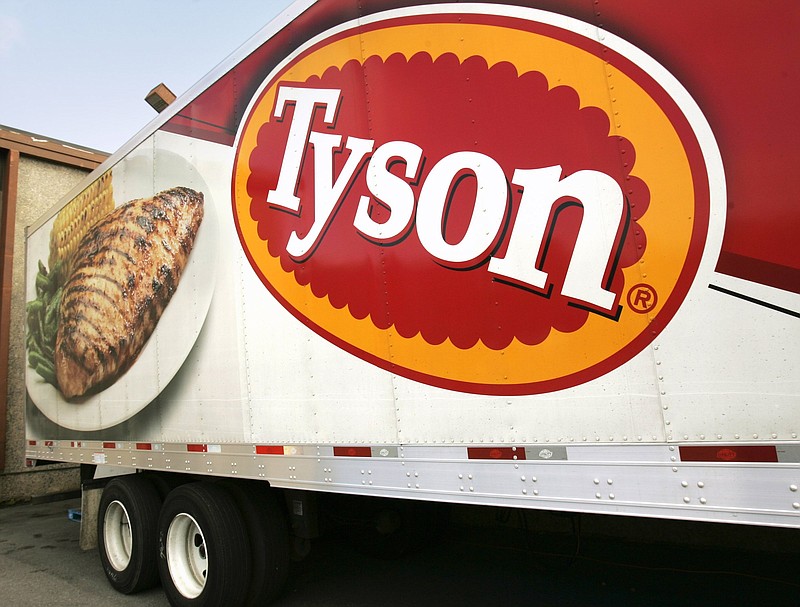Tyson Foods Inc. on Monday reported 2021 third-quarter net income of $749 million, a 42% gain from a year ago.
The nation's largest meat company delivered strong results, beating analyst expectations, during a time of labor challenges, inflationary pressures and supply chain issues.
Sales increased 25% to $12.5 billion as the restaurant industry began to recover from covid-19 restrictions and demand for beef exports escalated.
"Labor is our number one challenge," said Donnie King, Tyson's president and chief executive officer, in a Monday conference call with analysts.
Tyson sold more chicken, beef, pork and prepared-foods products in the three months that ended July 3 compared with the same period last year, but its only sizable operating income gain was reported in its beef segment -- due to ample cattle supply and a $55 million recovery from a supplier who pleaded guilty to scamming Tyson.
Rising grain costs, labor constraints and other headwinds related to the coronavirus pandemic ate into all segments of the business, but affected pork and chicken the most.
In an industry that struggles with high turnover and injury rates, the pandemic has sickened workers and accelerated absenteeism at processing plants across the country, reducing production rates.
Last week, Tyson issued a mandate for its entire U.S. workforce to be vaccinated by November, a trend among large corporations in response to the spreading delta variant. However, not everyone is on board.
The reaction from workers has been "somewhat mixed," King said. "We don't want to lose anyone."
When asked if workers have left the job over the mandate, he said that he was unaware of any and that it was too early to tell of the greater company impact.
More than 56,000 of Tyson's 120,000 workers have been vaccinated. A company spokesman on Monday said that 5,400 workers have at least received their first dose since the announcement.
If Tyson can make progress on its operational goals the company should be able to improve its results through 2022, Stephens Inc. analyst Ben Bienvenu said in a research brief.
During the third quarter, all of Tyson's segments faced headwinds from labor and production inefficiencies related to the pandemic. Some handled it better than others.
In the beef segment, sales soared 35.6% to $5 billion in the quarter compared with the same period last year. Operating income nearly doubled to $1.1 billion. The company attributed the results to strong global export demand, specifically to Asia.
Inflationary grain costs affected pork, chicken and prepared foods numbers because of the integrated nature of the businesses.
In the pork segment, sales climbed 54% to $1.7 billion in the quarter on stronger global demand. Operating income declined 37% to $67 million because of lower hog supplies and $45 million in net derivative losses.
In the chicken segment, sales climbed 12% to $3.5 billion. Tyson reported an operating loss of $279 million attributed to hundreds of millions of dollars in legal fees and increased feed costs.
During the quarter, Tyson's chicken segment incurred a $306 million legal charge and $270 million in higher feed costs compared with the same period last year. These amounts were offset by a $125 million net derivative gain.
Hatchery rates are on track to improve. Last quarter, King said the company would switch to a new type of male broiler after the last one negatively affected hatchery numbers. After testing the new bird, Tyson has plans to deploy it across operations in the coming months.
In the prepared-foods segment, sales rose 14% to $2.3 billion. Operating income increased 3% to $150 million. The company attributed this activity to restaurants and food service channels reopening. Results were offset by a $160 million increase in raw materials costs compared with the same quarter last year.
Overall, Bienvenu said the earnings beat came from higher gross profit, lower expenses and higher revenue. Tyson reported adjusted earnings per share of $2.70, beating the Stephens Inc. estimate of $1.52 and a FactSet analyst consensus of $1.61.
Looking ahead, Tyson is expecting higher beef margins year over year, lower pork and chicken margins and prepared foods to be about the same. It also plans to activate 12 new processing plants to meet global food demand.
Also Monday, chicken competitor Sanderson Farms said it has reached an agreement to be acquired by Cargill and Continental Grain for $4.5 billion, further consolidating an industry with a handful of major players. According to data cited by the Wall Street Journal, the combined operations of Sanderson and Wayne Farms, owned by Continental, would oversee about 15% of the country's chicken production.
King offered no comment on the matter.
Tyson shares climbed $6.16, or 8.7%, to close Monday at $77.30 on the New York Stock Exchange.

